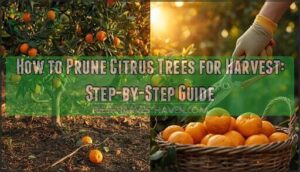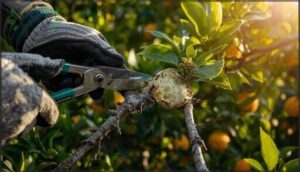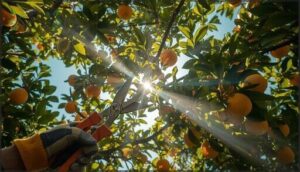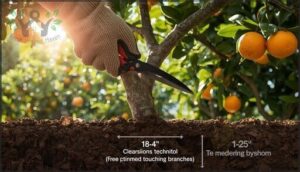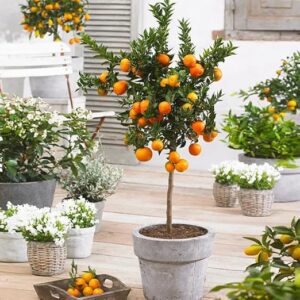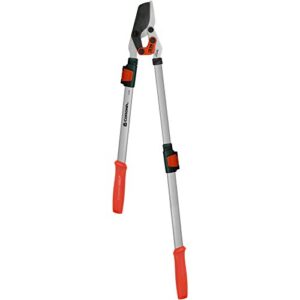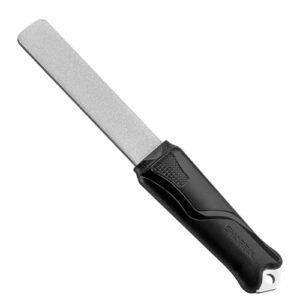This site is supported by our readers. We may earn a commission, at no cost to you, if you purchase through links.
You can spot a citrus tree that’s been neglected from across the yard—branches tangled like a pile of dropped jump ropes, fruit hidden in the shadows, and a canopy so dense it barely lets the sun through.
The secret to a heavy, healthy harvest isn’t just luck or good weather; it’s knowing exactly when and how to prune for maximum yield. Citrus tree pruning for harvest is less about hacking away and more about timing, technique, and a sharp eye for trouble spots.
Mastering this process means sweeter fruit, easier picking, and a tree that thrives season after season.
Table Of Contents
Key Takeaways
- Prune your citrus trees in late winter through early spring (late February to early April) to protect new growth from frost while maximizing flowering and fruit production for the coming season.
- Remove dead, damaged, and diseased wood first, then thin the canopy by 15-20% to improve airflow and light penetration, which directly boosts fruit quality and reduces fungal infections by up to 40%.
- Always sterilize your tools between cuts using 70% isopropyl alcohol to prevent disease spread, and make clean 45-degree angle cuts just above buds to promote faster healing and minimize pathogen entry.
- Limit total canopy removal to 20-30% annually to avoid stressing the tree—removing more than this can crash your yield by 30-40% and drain the tree’s energy reserves.
When to Prune Citrus Trees for Harvest
Timing your pruning right can make all the difference between a tree that thrives and one that struggles. You’ll want to work with your citrus tree’s natural rhythm, not against it.
Let’s look at when to prune for the best harvest results and when you should keep those shears in the shed.
Best Time of Year to Prune
Late winter through early spring—typically late February to early April—gives you the prime window for pruning citrus trees. This timing protects new growth from frost damage while setting up your tree for vigorous flowering and fruit production.
Consider these seasonal pruning schedules:
- Prune after the last frost to shield tender shoots from cold damage
- Target late winter in warmer climates; wait until early spring in cooler regions
- Avoid summer pruning when pests like citrus leaf miners peak
- Schedule yearly maintenance during mild winter months for ideal fruit yield
Proper citrus tree care is essential for a healthy harvest.
Signs Your Citrus Tree Needs Pruning
Your citrus tree speaks volumes about its pruning needs through visible damage like dead branches, crossing limbs, and dense canopies blocking sunlight. Watch for fruit decline in shaded interior areas—that’s your signal to thin the canopy. Suckers sprouting below the graft line steal energy from fruit production, while diseased wood threatens your entire harvest.
These pruning techniques improve tree shaping and disease control, delivering real pruning benefits you’ll see in next season’s yield. Proper tree care practices are essential for maintaining healthy citrus trees.
When Not to Prune Citrus Trees
Timing your pruning wrong can sabotage your harvest. Never prune citrus trees during frost damage risk periods—winter pruning invites cold injury to tender new growth. Skip rainy conditions entirely; moisture promotes disease spread through open cuts.
Avoid pruning during fruit development, or you’ll sacrifice your crop. Excessive pruning stresses trees and weakens structure. Your tree pruning guide starts with knowing when to hold back.
How Pruning Timing Affects Fruit Production
Your pruning schedule directly controls fruit yield management and tree energy balance. Post-harvest to pre-bloom pruning optimizes harvest time without sacrificing crops. Here’s how pruning methods shape production:
- Late winter pruning maximizes spring flowering and fruit set
- Post-heavy crop pruning can suppress next season’s yield through excessive vegetative growth
- Strategic timing balances canopy renewal with consistent annual production
Seasonal pruning strategies determine tomorrow’s harvest.
Essential Pruning Tools and Preparation
Before you make the first cut, you need the right gear in your hands. The tools you choose—and how you prepare them—directly impact the health of your tree and the quality of your harvest.
Let’s cover what you’ll need, how to get your tools ready, and how to set yourself up for a safe, successful pruning session.
Choosing The Right Pruning Tools
Your success starts with matching the tool to the branch. Hand pruners handle cuts under an inch, loppers tackle branches up to two inches, and a pruning saw manages anything thicker.
Tool material and handle ergonomics matter—sharp blades and comfortable grips boost cutting efficiency while reducing fatigue. Quality pruning tools transform tedious work into precise action, giving you control over every cut.
Sterilizing and Sharpening Tools
Before you make that first cut, your blades need attention. Disease Prevention starts with proper Tool Sanitation—infection rates plummet from 70% to under 10% when you follow strict Pruning Hygiene protocols.
- Sterilize your Hand Pruners, Loppers, and Pruning Saw between trees using 70% isopropyl alcohol or 1.5% bleach solution
- Keep a Sterile pair ready while another soaks
- Sharpen blades with dual grit diamond stones every 10-20 hours
- Clean sap and debris with warm soapy water before applying sterilizing agents
Equipment Maintenance and Blade Sharpening create cleaner cuts that heal faster, reducing stress and pathogen entry points.
Safety Tips for Citrus Tree Pruning
With over 648,000 pruning injuries treated in US emergency departments since 1990, proper Safety Gear isn’t optional. Cut-resistant gloves shield your hands from thorns and blade slips, while safety glasses block flying debris—lacerations account for 71% of all Pruning Hazards.
Closed-toe boots, sharp secateurs, and ergonomic tool grips reduce Accident Reduction risks. Injury Prevention starts before you touch the pruning saw.
Preparing The Tree and Area for Pruning
Before you prune citrus trees, walk a full circle around your tree—spot those crossing limbs, diseased wood, and rootstock suckers stealing energy. A proper Tree Inspection shapes your Pruning Plans.
- Branch Clearance: Remove weeds and debris 3 feet around the base to cut pest habitats by 30% and improve Workspace Safety.
- Debris Management: Bag fallen leaves that harbor pathogens near fresh branch collars.
- Tool positioning: Stage sterilized equipment within arm’s reach for efficient cuts.
Step-by-Step Citrus Tree Pruning Guide
Pruning your citrus tree the right way takes more than just grabbing your tools and making random cuts. You’ll need to follow a logical sequence that puts the tree’s health first while setting it up for a productive harvest season.
Here’s how to tackle each step with confidence and precision.
Removing Dead, Damaged, and Diseased Wood
Dead wood removal starts your citrus tree care routine by eliminating disease harbors and decay risks. Prune citrus trees every two to five years, targeting branches that look gray, brittle, or cracked.
Cut diseased wood back to healthy tissue using sterilized tools, making clean 45-degree angles just above a bud. This tree hygiene approach prevents fungal spores from spreading while redirecting energy toward fruit production.
Thinning The Canopy for Airflow and Light
Think of your citrus canopy as a solar panel—blocking light equals blocking production. Thinning tree canopy by removing 15-20% of overlapping interior branches transforms dense foliage into a productive powerhouse.
Air circulation improves dramatically when you target crisscrossing shoots and shaded scaffolds, reducing fungal hotspots by up to 40%. Light penetration reaches inner fruiting zones, directly improving fruit production quality and size.
Strategic canopy thinning makes every pruning cut count toward your harvest goals.
Skirting and Lower Branch Removal
After improving airflow through canopy management, ground-level branch removal completes your tree pruning guide. Skirting your citrus trees every 2-3 years—cutting branches 18-24 inches above ground—unlocks serious orchard sanitation benefits while simplifying irrigation access.
When you prune citrus trees at the base, you’re investing in long-term fruit yield and disease resistance:
- Remove all branches touching or near the soil surface
- Clear growth up to 24 inches for ideal airflow
- Cut just outside the branch collar for fastest healing
- Target no more than 20% total canopy removal
- Time skirting during dormant or post-harvest periods
This strategic branch pruning reduces fungal infections by 40%, prevents rodent damage, and makes fertilizer application easy. Your tree branches stay healthy while harvest efficiency skyrockets—mechanical studies show 23% higher profitability through proper lower branch removal.
Reducing Tree Height for Easy Harvest
Once your base is clean, tackling canopy management at the top transforms harvest efficiency. Reducing tree height to 10-12 feet through drop-crotch pruning techniques—never topping—puts fruit within easy reach while maintaining tree health.
Remove no more than 20-30% of upper growth annually, working downward from the highest branches. This strategic approach to citrus tree pruning cuts labor costs and eliminates dangerous ladder work.
Shaping for Optimal Fruit Production
Your citrus tree’s architecture determines fruit yield. Shape scaffold branches at 45° angles spaced 10-15 cm apart vertically—this canopy management increases productivity by up to 30 kg annually. Train your tree to a vase-like or modified central leader form using these pruning strategies:
- Remove competing leaders to establish clear branch hierarchy
- Thin crossing branches to prevent rubbing and disease entry
- Open the center for 20-40% better light penetration
- Maintain branch spacing that facilitates balanced fruit distribution
Strategic tree shaping techniques boost both harvest convenience and long-term health.
Citrus Tree Pruning Techniques and Best Practices
Getting your cuts right makes all the difference between a tree that heals fast and one that struggles with disease or damage. The way you approach each branch—from where you position your blade to how you manage the tree’s natural defenses—directly impacts your harvest down the line.
Let’s walk through the essential techniques that’ll keep your citrus trees healthy, productive, and easy to maintain year after year.
Making Clean Cuts and Protecting Exposed Wood
Your pruning techniques are crucial when caring for citrus trees. Make each cut at a sharp 45-degree angle, ¼ inch above a bud, while avoiding the branch collar to promote faster wound healing. Sterilize your tools with isopropyl alcohol between cuts to prevent the spread of disease.
| Cut Type | Tool | Angle |
|---|---|---|
| Small branches | Hand pruners | 45-degree |
| Medium limbs | Loppers | 45-degree |
| Dead, damaged, or diseased branches | Sterilized saw | Flush to collar |
Protecting exposed wood is essential. Apply diluted white paint to prevent sunburn and encourage natural wound healing.
Using The Three-Part Cut for Large Branches
When you’re tackling branches over 1.5 inches thick, master the three-part cutting technique to prevent bark tearing and protect your tree’s healing capacity.
Start with an undercut five inches from the trunk, going halfway through. Make your second cut a few inches beyond this to drop the weight safely.
Managing Suckers and Water Sprouts
Those vertical shoots stealing nutrients from your fruit production? They’re robbing up to 20% of your tree’s resources. Attack suckers and water sprouts when they’re under 12 inches—you’ll slash regrowth by 60% with proper pruning techniques.
Here’s your action plan for canopy management:
- Remove shoots at their base using sterilized hand pruners
- Target spring growth between February and April
- Check every 6-8 weeks during growing season
- Preserve horizontal, fruit-bearing branches while removing vertical growth
Regular sucker removal boosts fruit yield by 10-20% annually.
Preventing Disease Entry Points
Every cut you make opens a door for pathogens—but proper pruning hygiene slams it shut. Sterilize your tools in a 10% bleach solution between cuts; this infection control method achieves 100% pathogen elimination.
Wounds stay vulnerable for four weeks, so timing matters. Pruning citrus trees during dry conditions cuts infection risk in half.
Apply biological wound care products within hours for 90-93% disease prevention success.
Gradual Pruning to Avoid Tree Stress
Think of your tree’s energy reserves like a bank account—withdrawing too much at once leaves it broke. Prune citrus trees by removing just 20% of the canopy annually, and you’ll maintain 85% canopy retention while avoiding the 30-40% yield crash that drastic cuts cause.
Treat your citrus tree’s canopy like a savings account—remove just 20% each year to avoid a drastic yield crash
Removing dead, damaged, or diseased wood first, then shaping gradually, keeps your tree thriving through every harvest cycle.
Tree Stress Reduction strategies:
- Monitor carbohydrate levels before pruning for fruit production
- Space sessions across multiple seasons for canopy management
- Whitewash exposed bark immediately after cuts
- Track stress indicator monitoring through leaf color
- Target fruit yield optimization with measured pruning frequency
Top 6 Tools and Products for Citrus Pruning
Your pruning results depend heavily on the quality of your tools and how well you maintain them. Sharp, clean equipment makes precision cuts that heal quickly, while dull or contaminated tools can damage your trees and spread disease.
Here are six essential products that’ll help you prune like a pro and keep your citrus trees healthy for years to come.
1. Isopropyl Rubbing Alcohol Disinfectant Solution
Before you make a single cut, sterilizing your pruning tools protects your citrus investment from disease spread. The Dealmed 70% Isopropyl Rubbing Alcohol hits the sweet spot for disinfectant properties—concentrated enough to penetrate microbial cell walls but slow-evaporating for proper tool sterilization.
This alcohol concentration is proven effective against bacteria and fungi common in citrus tree care. Spray tools between cuts, allow thirty seconds of contact time, and you’ve created a safety barrier.
It’s environmentally friendlier than bleach and evaporates residue-free, keeping your plant health management practices both effective and responsible.
Best For: Citrus growers and home gardeners who need reliable tool sterilization between cuts to prevent disease transmission in their trees.
- 70% concentration provides optimal disinfection effectiveness by allowing enough contact time to penetrate and kill bacteria and fungi without evaporating too quickly
- Leaves no harmful residue on tools since it evaporates completely, making it safe for immediate use on plants after sterilization
- More environmentally friendly than bleach-based alternatives while still delivering effective pathogen control for pruning equipment
- Cannot eliminate bacterial spores or certain resistant viruses, so it’s not a complete sterilization solution for all potential pathogens
- Flammable nature requires careful storage and handling, especially when used frequently in outdoor settings
- Must be reapplied between each cut or tree to maintain protection, which can slow down larger pruning jobs
2. Silky Professional Arborist Hand Saw
When branches exceed two inches, your hand pruners won’t cut it—literally. The Silky Professional Arborist Hand Saw delivers the cutting power you need for efficient citrus tree pruning.
Its 13-inch blade with impulse-hardened teeth handles thick limbs while maintaining hand saw ergonomics that reduce fatigue during extended sessions. The chrome-plated steel resists rust in humid orchards, and proper saw blade maintenance keeps it sharp for months.
Yes, blade replacement costs run about 11% less than new tools, making this investment practical for serious pruning work focused on removing dead, damaged, diseased wood.
Best For: Professional arborists and experienced gardeners who regularly prune thick branches and need a durable saw that stays sharp through months of heavy use.
- Cuts through branches up to 6.5 inches thick with impulse-hardened teeth that stay sharp far longer than standard saws
- Chrome-plated blade resists rust in humid conditions, and the ergonomic handle reduces hand fatigue during long pruning sessions
- Replacement blades cost about 11% less than buying a new saw, making maintenance affordable for professionals
- Higher upfront cost compared to basic pruning saws, which may not be justified for occasional home use
- Requires a diamond file for sharpening due to the specialized tooth hardening, adding to maintenance complexity
- Some blade flex when cutting thicker branches, and the plastic scabbard can wear out with heavy field use
3. Owari Satsuma Mandarin Tree Plant
Your pruning techniques directly influence what you’re actually growing. The Owari Satsuma Mandarin Tree Plant thrives with proper citrus tree care, producing 40 to 218 pounds of seedless fruit annually when you master tree pruning tips that match its growth habits.
This compact variety reaches 3–10 feet, making satsuma harvesting accessible without ladders. Apply your pruning knowledge during late winter fertilization cycles—satsuma mandarins reward consistent mandarin tree care with sweet, easy-peel fruit by late fall.
Fruit production tips? Start with well-drained soil and prune for an open canopy structure.
Best For: Gardeners who want fresh citrus in colder climates without needing a full-sized orchard—this tree grows 3–10 feet, handles brief dips to 12–15°F, and works indoors or on patios.
- Produces 40–218 pounds of sweet, seedless mandarins annually once established, with fruit ready by late fall
- Compact size makes harvesting easy without ladders, and it thrives in containers or small yards
- Hardy enough for USDA Zone 4 when protected, letting you grow oranges where citrus normally can’t survive
- Can’t ship to AL, AZ, CA, FL, GA, LA, OR, TX, MS due to federal restrictions
- Some buyers report smaller or less healthy plants on arrival, requiring extra care to recover
- Takes 1–2 years before fruiting starts, and yields drop in “off” years due to alternate bearing patterns
4. Extendable Bypass Tree Loppers Tool
If you’ve ever wished for more reach and less strain while pruning, extendable bypass tree loppers are your answer. The ergonomic design and bypass mechanism deliver cutting precision, making quick work of branches up to 1¾ inches.
With telescoping arms and comfort grips, you’ll boost pruning efficiency without sacrificing control. Tool maintenance is simple—just keep those alloy steel blades sharp and clean.
These loppers are a game changer for citrus tree pruning, especially when tackling those awkward, higher cuts.
Best For: Home gardeners and professional landscapers who need to prune hard-to-reach branches with minimal effort.
- Telescoping handles let you reach high branches without a ladder.
- Bypass blades make clean, precise cuts for healthier trees.
- Comfort grips and shock-absorbing bumpers reduce hand and shoulder fatigue.
- At 4 pounds, the tool can feel heavy during long pruning sessions.
- It’s harder to use overhead when handles are fully extended.
- Not ideal for users with limited upper body strength.
5. Nagami Kumquat Fruit Tree Plant
With your extendable loppers in hand, turn your attention to the Nagami Kumquat Fruit Tree Plant—a compact powerhouse for fruit yield and ornamental appeal. This citrus tree thrives in containers, making it a favorite for adventurous growers seeking control over tree shape and size.
Careful pruning tips, such as limiting foliage removal to 20%, keep Nagami growth steady and productive. Regular fruit tree maintenance ensures those fragrant blossoms and bright orange fruits remain the stars of your patio. Remember: precise citrus tree pruning tips boost harvest and health.
Best For: Home gardeners and citrus lovers who want a compact, low-maintenance fruit tree that thrives in containers and adds beauty to patios or small gardens.
- Produces sweet, edible-skinned fruit nearly year-round, perfect for snacking and cooking.
- Compact size and cold tolerance make it ideal for container growing in cooler climates.
- Fragrant blossoms and bright orange fruits offer ornamental appeal for patios or balconies.
- Very small starter size (2-5 inches tall) means slow initial growth and delayed fruiting.
- Fruit quality may vary since it’s grown from seed and not guaranteed to match the parent tree.
- Needs careful watering, sunlight, and pruning—some growers report challenges with plant survival.
6. Dual Grit Diamond Sharpening Stone
Once your Nagami Kumquat is shaped just right, don’t overlook your tools—sharp pruning shears are the backbone of every clean cut. That’s where a dual grit diamond sharpening stone shines. Its monocrystalline surface boosts pruning efficiency and keeps blades razor-sharp, no matter how thick the branch.
You’ll appreciate the stone’s durability and easy diamond maintenance—just a quick wash and it’s ready. Sharpening techniques with this tool mean smoother tree pruning methods and longer-lasting edges, making every harvest a little easier.
Best For: Gardeners, woodworkers, and DIYers who need a reliable, portable sharpening tool for maintaining blades in the field or at home.
- Dual grit surface quickly restores and polishes edges for a razor-sharp finish.
- No oil or water needed—easy to use and clean, even on the go.
- Durable diamond coating ensures long-lasting performance across many tool types.
- Diamond coating may wear down with heavy, repeated use.
- Leather strop included isn’t ideal for precision blade finishing.
- Requires proper sharpening technique for best results.
Frequently Asked Questions (FAQs)
How does pruning affect citrus tree lifespan?
Clear cuts, careful timing, and consistent tree maintenance mean stronger roots, healthier branches, and longer life.
Pruning Effects reach beyond shape—boosting Tree Longevity, Fruit Yield, and Disease Control.
Smart Pruning Strategies are your best Plant Health Management tool.
Can pruning help control citrus tree pests?
Yes, pruning benefits pest control by removing infested branches, improving airflow, and reducing disease reservoirs. It enhances spray penetration and bolsters integrated management strategies, strengthening tree hygiene and overall plant health through proper citrus tree care and maintenance.
Does pruning impact citrus tree drought tolerance?
Strategic pruning boosts citrus tree drought tolerance by reducing canopy size and water demand. Hedging can save up to 50% water annually, while pairing pruning strategies with drought-resistant rootstock selection strengthens tree resilience during water stress.
What are common pruning mistakes to avoid?
Common tree pruning mistakes include over pruning, which weakens citrus trees and reduces fruit yield, using dirty pruning tools that cause disease spread, making incorrect cuts, and timing errors that lead to tree damage.
How do different citrus varieties respond to pruning?
Different citrus varieties show unique pruning responses. Lemons like ‘Fino 95’ thrive with mechanical pruning, while Valencia tolerates late-season cuts.
Mandarin and kumquat varieties need careful structural pruning to optimize fruit quality and production.
Conclusion
Don’t leaf your citrus trees to chance—master citrus tree pruning for harvest and watch your yields soar. You’ve learned when to cut, which branches to remove, and how to shape for maximum production.
Now it’s time to grab your tools, step into the grove, and make those strategic cuts. Every snip you make isn’t just trimming; it’s setting the stage for sweeter fruit, easier picking, and seasons of abundant harvests ahead.

